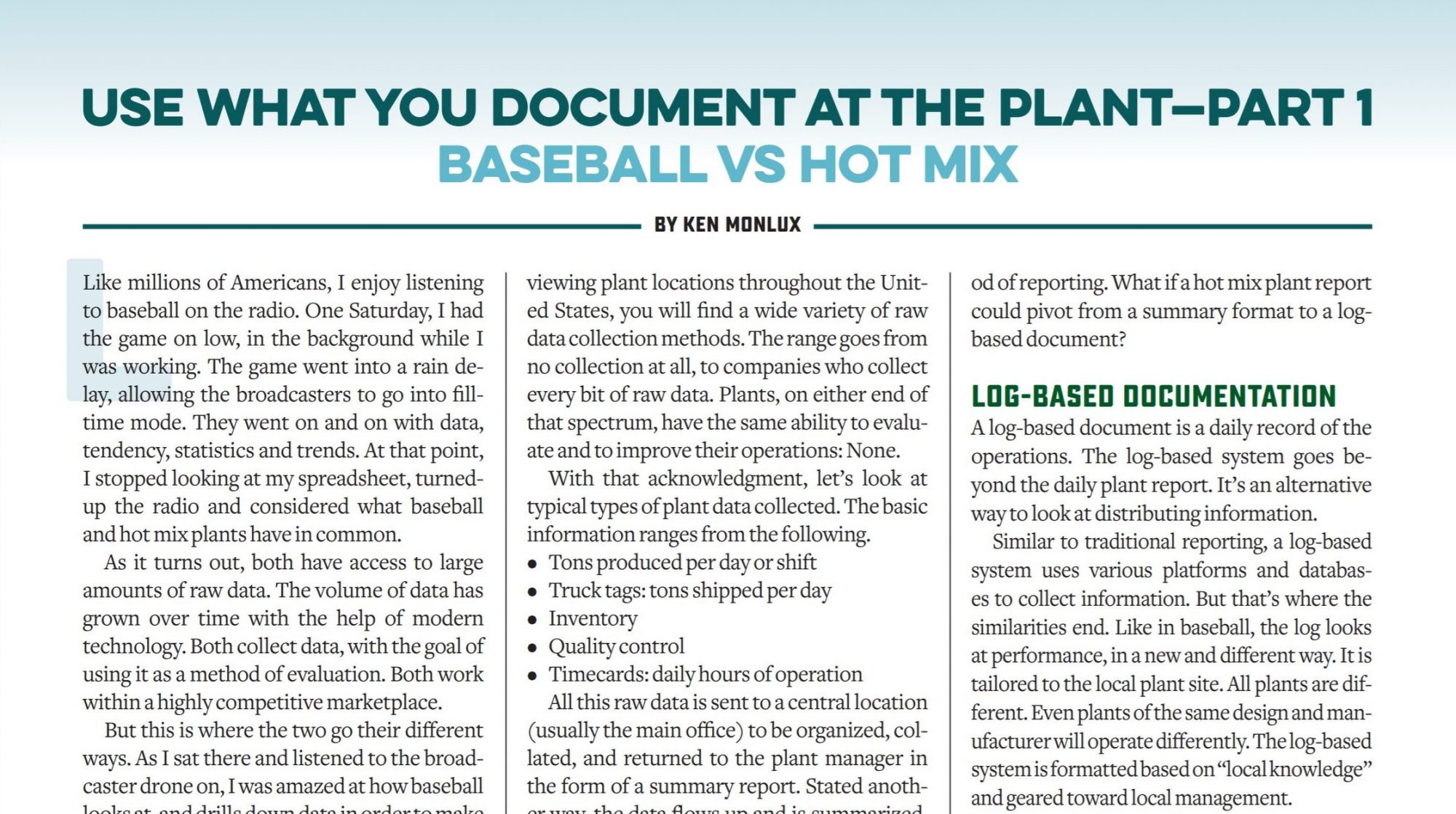Collect, Evaluate Asphalt Plant Data Honestly
BY Ken Monlux

Like millions of Americans, I enjoy listening to baseball on the radio. One Saturday, I had the game on low, in the background while I was working. The game went into a rain delay, allowing the broadcasters to go into fill-time mode. They went on and on with data, tendency, statistics and trends. At that point, I stopped looking at my spreadsheet, turned-up the radio and considered what baseball and hot mix plants have in common.
As it turns out, both have access to large amounts of raw data. The volume of data has grown over time with the help of modern technology. Both collect data, with the goal of using it as a method of evaluation. Both work within a highly competitive marketplace.
But this is where the two go their different ways. As I sat there and listened to the broadcaster drone on, I was amazed at how baseball looks at, and drills down data in order to make an improvement to the team.
This is the starting point in my comparison of the two industries. Fans sometimes forget that baseball is a business. Like all businesses, teams need: a quality product (a winning team) to sell; a requirement to evaluate their performance and make decisions to improve; and to grow their customer base.
Sound familiar? It did to me. I asked myself what baseball could teach the hot mix industry about how to use data to improve their business. To learn the lesson of baseball, I turned to Bill James, the father of “Moneyball.” While James did not invent baseball statistics, he discovered there could be a different and better way to collect and analyze data. Looking at the same data in a unique way, he was able to pull out additional and enhanced information.
For example, batting average was out, and on-base percentage was in. He was able to see and evaluate talent (the product) in a new way. He put aside the traditional way of evaluating the game and never looked back.
The take-away for managers of asphalt plants is to get honest about how we collect and evaluate plant data.
A modern hot mix plant, in the course of a production day, will develop a lot of raw data. Some is recorded, some is shown on a dashboard in real time, and other data is in written summaries (end-of-shift reports). In reviewing plant locations throughout the United States, you will find a wide variety of raw data collection methods. The range goes from no collection at all, to companies who collect every bit of raw data. Plants, on either end of that spectrum, have the same ability to evaluate and to improve their operations: None.
With that acknowledgment, let’s look at typical types of plant data collected. The basic information ranges from the following.
- Tons produced per day or shift
- Truck tags: tons shipped per day
- Inventory
- Quality control
- Timecards: daily hours of operation
All this raw data is sent to a central location (usually the main office) to be organized, collated, and returned to the plant manager in the form of a summary report. Stated another way, the data flows up and is summarized, and then is distributed down to the plants. It is not uncommon for the formatting of these reports to be geared toward upper management, not the local manager.
Some firms have spent large amounts of money to build ever more technical and complicated systems. In an effort to capture every variable in production, they can, if not careful, lose sight of the goal of improvement. They can focus too much on today’s in-vogue data point, or of one particular segment of the operation, and become blind to long-term trends.
This traditional method of reporting requires the plant manager to have the ability and the aspiration to perform the needed analysis. The quality of this analysis can differ widely based on a number of factors.
- The plant manager’s background: i.e. education, training
- Time management: Does the manager make the time to evaluate and unearth the benefits of the report?
- The time lag in the daily data collection and the monthly distribution of the report
- Desire: Does the manager have the desire to use the report to improve the plant operation?
Once again, looking at how most baseball teams now look at data collection, and the ingenious way they analyze the data to get an advantage over other teams, I would like to propose hot mix companies rethink their method of reporting. What if a hot mix plant report could pivot from a summary format to a log-based document?
Log-Based Documentation
A log-based document is a daily record of the operations. The log-based system goes beyond the daily plant report. It’s an alternative way to look at distributing information.
Similar to traditional reporting, a log-based system uses various platforms and databases to collect information. But that’s where the similarities end. Like in baseball, the log looks at performance, in a new and different way. It is tailored to the local plant site. All plants are different. Even plants of the same design and manufacturer will operate differently. The log-based system is formatted based on “local knowledge” and geared toward local management.
A log-based system is not meant to be a replacement of the decision-making responsibility of the managerial team or a financial-based report filled with a massive amount of numbers. It shouldn’t be used to make judgments on the operational decisions.
Instead, we can define a log-based system as:
- An easy-to-read archive of operational performance;
- An interactive communication tool, allowing local management to ask questions, seek advice, or just a sounding board for concerns;
- Able to easily reconstruct any given day of operation;
- A way to distill data down to five key components or vital signs to highlight success; and
- Designed to challenge the manager, to redefine new issues, and challenge again.
The vital signs mentioned as part of the log-based system are five bullet points to summarize the plant’s health. They are simple, site-specific and goal-oriented. Each vital sign is constructed to allow local management to make simple changes. They are limited to five to provide quality information without the risk of data overload. Think of them as the top five signs of health a team doctor would collect or assess at each doctor visit the baseball player makes. The doctor takes the athlete’s blood pressure and oxygen saturation number, has him step on a scale to check his weight, and perhaps takes a blood sample for a white blood cell count. These are the vital signs regularly checked by the doctor; you will decide on the vital signs regularly checked at your plant for the log-based system.
In addition to the vital signs, the log-based format has other areas of describing the operations of the plant.
- Narrative overview from the plant performance
- Recap of conversations between the editor and the manager
- Day-to-day summary of weather
- Appendix I: Daily Shift Plant Report (an electronic copy of the plant reports by date)
- Appendix II: Inventory
- Appendix III: List of in-house or outside major projects supplied
- Appendix IV: Quality Control spreadsheet, based on data supplied by in-house QC dept
To achieve the stated goal of a log-based system, an extra step is needed prior to the report being delivered. This extra step allows the manager to expedite their comprehension of the report.
Numbers alone don’t tell you much unless you can read them in a timely manner. By reviewing on a daily basis, the editor of the log is looking for issues that may hamper the operation.
In the task of producing the “Vital Signs,” an independent and experienced professional would review the collected data. This extra step also allows for questionable issues to be discovered in a timely manner. Stated another way, if a question comes up, the manager is notified, and has the ability to adjust in an appropriate time. A log-based system does not make the decisions in the operation; it draws attention to a trend or a process that does not look right.
In Conclusion
Like baseball teams in the mid ’90s, you may be dissatisfied with your data evaluation and analysis reports. If your team doesn’t benefit from your current method of reporting, you may need to reevaluate the current method. Remember that change is hard.
This was a difficult lesson for MLB to learn. They got pushback from the players, managers, scouts and even the front office. In a world of traditions, old habits are hard to change. To be the first, to look at going a different way, is never easy. Working outside the box is never comfortable, but for the ones that are willing, the reward is worth it.
It was only when one team took a chance that the rest of the league changed. Now there’s no looking back. Moneyball is the law of the land. Yes, traditional statistics have their place in the locker room and among the fans. However, when the game is on the line, or when they think about making a trade, or evaluating a rookie, teams turn to Moneyball.
It may be the same for you. If your management team is willing to rock the boat a little, look at data in a different way, you may find a better path. Given time, your management team will come to trust a log-based system. It’s never bad to have an independent sounding board, someone in your corner to confirm your day-to-day decisions. If given a chance, it will save you time and feature your manager’s abilities.

Ken Monlux
Ken Monlux is an asphalt industry veteran with 30 years experience in all areas of operational management. For more information, contact him at (209) 495-1017 or kenmonlux@yahoo.com.
